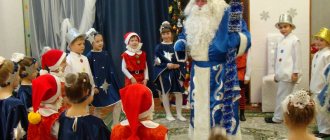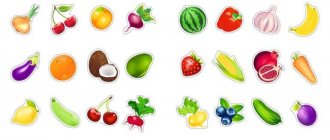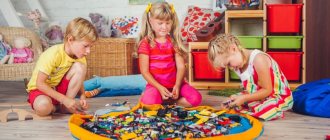Toys for speech development of babies up to 1 year old
Pyramid (from 6 months). A correct pyramid must meet the following requirements:
- The first pyramid should have no more than 5 rings.
- The pyramid rod must have the same thickness along its entire length.
- The size of the holes in all rings should be the same.
- The pyramid must have a stable base.
- For children over one year old, all pyramid rings must have the same color.
With the help of a pyramid, the baby will develop motor skills, which have a huge impact on speech development. Master the concepts of “big - small”. In addition, he will master sorting, basic comparison skills, counting, and become familiar with primary colors.
Balls (from 6 months). A variety of sizes, colors and properties (smooth and pimply, hard and soft, heavy and light) is desirable. Balls are great for a child's physical development. In addition, they perfectly contribute to the development of thinking. With their help, you can teach your child to compare, classify, study colors, sizes, and practice a vocabulary of adjectives.
Cubes (from 7 months). The set should consist of different shapes: cube, brick, prisms, cylinders. These details are good material for the development of thinking, imagination, and fantasy. An older child can build entire cities and write stories about them, which is an excellent tool for developing coherent speech. Using a set of cubes, you can get acquainted with mathematics: study counting, shapes, and magnitude.
Car on a string (from 7 months). By simply pulling a toy by the string, the child first develops a conclusion about cause-and-effect relationships. At the age of 8 months, a dump truck is needed - the baby turns the wheels, learns to drive the car, avoid obstacles, carry various objects in the back and unload them, and roll his favorite toys. Thus, the child develops spatial concepts and practices prepositions and prefixes.
Doll (from 8 months). An ordinary doll is necessary for all children, regardless of gender. Since she is a projection of a person in the toy world. With the doll, the baby learns to show and name parts of the body; with it, you can play out various routine moments and everyday situations. This is how the baby first realizes his place in the world around him and his personality develops. By playing with a doll, you can expand your vocabulary of nouns on various topics, learn verbs, study body parts, and items of clothing.
Toys for children over 4 years old
At this age, children begin to gradually become familiar with the alphabet, and games for preschool age become more and more diverse:
- Cubes, busy boards, sorters. They depict letters and objects whose names begin with them. For example, “N” – “threads”, etc. In such games, the help of adults is important. Voice letters and words so that kids hear and remember the correct pronunciation. Talk with your child. It is also important to encourage the baby to find a specific letter. The listed toys are more effective than educational books, because... in this case, motor skills develop better (the child spins cubes, opens windows on busy boards, etc.) and there is no purely teaching moment. After all, learning and playing at the same time is much more interesting.
- Designers. They are useful for preschoolers because they develop the speech-thinking centers of the brain. The kid examines the details, sorts them, looks for matches, collects something new, guided only by his imagination. To enhance the impact on the speech apparatus, invite your child to say out loud his actions, thoughts, voice what he is doing and what happened as a result. As a toy that develops speech, for 4-year-old boys you can consider a construction toy car, and for girls - doll houses.
- Cube with dots. An interesting activity for children 5 years old. Invite your child to roll the dice and name (to choose from) the same number of objects or syllables as there are dots. This game develops spatial thinking and trains mental arithmetic before school. You can also use logical pyramids, abacus, which depict numbers and several objects. Invite your child to name the first syllables of the colors of the details of the pyramid or name words consisting of that many letters.
Read more about toys that will help your child prepare for school in our blog. Don't forget that children's toys for speech development will be especially effective if you also participate in the games. Help your child, guide him, come up with original, non-standard uses for familiar things, and the result will not keep you waiting
Toys for children's speech development after 1 year
Matryoshka. In terms of its purpose, a nesting doll is similar to a pyramid, but on a more complex level. Simple manipulations with a nesting doll are accessible even to a child. As you get older, there are more and more options for playing with matryoshka dolls. It helps in mastering ordinal numbers, comparative forms of adjectives, and prepositions.
Musical instruments (xylophone, drum, tambourine). Instruments are necessary to develop a sense of rhythm. Tapping a rhythm and performing movements to a given rhythm plays an important role in the formation of speech processes, in particular, phonemic hearing. Musical instruments will be useful in theatrical performances, as well as in role-playing games.
Sorter. With its help, the child learns to correlate three-dimensional figures in shape and size with their flat image. Logic, visual memory, thinking, and fine motor skills develop. The first sorter should have no more than three holes of simple shapes. If there are too many of them, it is difficult for the child to complete the task, and he does not receive satisfaction from the game. When the child learns to cope with a simple sorter, you can increase the number of holes and the variety of shapes.
Insert frames . It is desirable that the elements are the same color and are evenly inserted into place. The child will recognize figures by their contours to form visual images of them. When choosing inserts, you need to pay attention to ensure that you cannot insert the figure incorrectly. When the child can correctly determine the place of the insert in the frame, you can try inserting the figures with their eyes closed, thereby developing tactile sensations, imaginative thinking, and coordination. Speech development occurs: the child first understands and then pronounces independently who or what is in front of him, what properties he has, what actions this item or object can perform. Elements of the inserts can be used in theatrical games and in practicing individual aspects of speech.
Dishes . The process of eating has an important place in people's lives; the strongest feelings are associated with it - hunger and satiety. A significant portion of time is spent on food, so it is important to pay due attention to playing with dishes. In the process of eating, a story game develops, which is a powerful stimulus for the development of speech and thinking. Playing with children's dishes perfectly engages fine motor skills and actively develops sensory sensations. This game promotes the formation of logical operations and develops the skill of simple arithmetic operations.
Figures of animals and people . They allow you to reproduce the real world in the game. The child creates a game world and fills it with characters. This is not only a game, the figures are an ideal aid for development. We cannot do without speech - we name the characters, tell stories about them. By naming animal body parts, you can practice possessive adjectives and write descriptive stories. Animals can be classified according to their mode of movement, habitat, and appearance. When simulating real actions, coherent speech is formed, thinking, imagination, and fantasy develop.
For children from 3 to 4 years old
The main task of teachers and parents at this age is the child’s adaptation in kindergarten. Kids who spent a lot of time with their parents and relatives begin to get used to the new team. Developmental speech therapy games will help them with this:
- Busy boards based on fairy tales. An interesting game that develops imagination, speech, teaches young viewers to empathize with the characters of the performance and even acting skills. At first, the parents themselves show the performance, explaining to their child how to open the windows and what to do. During the performance, you can ask your viewer: “What does this cow do?” or “How sad is the top?”, etc. Then the child himself will want to try to “play out” some scene with the help of heroes hidden behind the “windows”. By opening windows, locks, lacing the “ladder”, he will develop the flexibility of his fingers, movements, and by pronouncing the characters’ lines – his speech apparatus.
- Magic box with surprises. Toys for 3-year-olds must include objects for imagination and tactile perception. Invite your child’s friends over and invite them to take turns taking small figures, safe embossed objects, etc. out of the “magic box.” Children will be happy to touch an unknown object and guess what it is. Ask the company to talk about what they pulled out: “What does this item do?”, “What color is it?” etc.
- Musical instruments. Children 3-4 years old are interested in trying to reproduce sounds themselves using musical instruments. Percussion is especially useful - it develops meaningful movements and interaction between both hemispheres. The child learns to hold the stick more confidently and remembers different tones of sounds. Using xylophones/metallophones you can sing words and rhymes. And this contributes to rapid “pronunciation” and beautiful speech without errors.
At 4 years old, the child continues to study in the middle group of kindergarten, he has already adapted to the team, and it’s time to prepare for school.
Didactic exercises for children 6 or 7 years old
Games to develop speech in the older group are a little more difficult, since by this age the children have already mastered basic speech skills, and they need to improve it.
"Warm - cold"
Didactic games for the development of speech in preschoolers of this type are aimed at finding antonyms of words.
Before performing it, you need to make sure that the child understands the meaning of the words “different”, “opposite”, “similar”, “same”.
The teacher gives a word and a phrase to the child so that he says the opposite expression (big ball - small ball, long ribbon - short ribbon, white figurine - black figurine, light cube - heavy cube, deep pond - shallow pond, cheerful boy - sad boy , the weather is clear - the weather is cloudy).
Didactic games on antonyms can be complicated by adding not only an adjective, but also a noun for replacement (clear day - rainy night, warm summer - cold winter).
Relatives
The exercise helps the preschooler understand family relationships and establish the degree of relationship between people.
As part of an exercise to develop an understanding of kinship, the teacher asks questions about family ties, and the child must answer them:
- who are you to your mother and grandmother (son/daughter, grandson/granddaughter);
- who is your father's brother (uncle);
- Who is your father's brother's daughter (cousin)?
To make a sentence
Didactic games on sentences help to increase the attention of a preschooler and teach him to correctly coordinate words. The speech therapist gives 2 words that do not agree with each other, and the child makes a phrase or sentence out of them.
For example, a teacher says “the ball is jumping”, and a preschooler says “the ball is jumping”, “the girl is swimming” - “the girl is swimming”.
Professions
Speech development games for preschoolers related to professions improve the child’s knowledge in professional areas, and also teach him to form one part of speech into another.
The teacher, offering such didactic word games, gives the name of the profession, and the preschooler says what such a person does. For example:
- builder - builds;
- doctor - treats.
Diminutive words
Didactic games on word forms teach you to form diminutive forms of words known to children. The teacher imposes the word in its usual form, and the student - in its diminutive form:
- doll - doll;
- bag - handbag;
- scarf - scarf.
Didactic games to improve speech are one of the simplest and most effective ways to improve children's communication skills and teach them to distinguish the forms of words, as well as their meanings.
For different groups of children, the complexity of the exercises is different - speech development games in the older group are much more difficult than in the younger ones. Parents can come up with tasks on their own using examples, or you can turn to speech therapists for help.
Board with windows and latches Melissa and Doug
Although we have many different busy boards in the center, this is the board with windows that children most often choose. What's the secret? Educational toys for children with mental retardation from the company Melissa and Doug from the USA are very high quality and durable.
Of course, this is important: when buying a toy for a child with special needs, you need to think about safety first. But children hardly think about this. Most likely they are attracted by the size and shape of the locks. The owners of Melissa and Doug have their own children help them test toys, which may be the key to their success.
Main types of didactic games
In total, in pedagogy there are 3 types of didactic games for preschool children (they have one goal - speech development):
- didactic word games with objects, toys;
- board games with printed materials;
- word games.
Sometimes didactic games for speech development are also distinguished by age - some tasks are designed for children 3-5 years old (younger preschool age), they allow you to teach a child to speak correctly faster. And others - for children 6-7 years old (senior preschool age), allow you to correct and improve existing speech skills.
Each type should be considered in more detail.
Educational toys and games for children with mental retardation
Victoria Efimova, candidate of pedagogical sciences, psychophysiologist, speech therapist, manager (St. Petersburg)
If a child is developmentally delayed and has a diagnosis of mental retardation or mental retardation, does he need any special correctional and developmental toys? When choosing educational games and toys for children with mental retardation, it is important to take into account not the diagnosis, but the personal characteristics of your child’s development.
Watch your child. Do you think he is not interested in toys? But perhaps you are offering what you like, not what he likes.
Observing what children choose during consultations and classes at, we have compiled a list of the most favorite toys of most preschool children. And these games and toys are great for educational activities.
Hedgehog constructor
This is the most popular game. Many children with mental retardation have difficulties with motor skills: fine and gross. Often a child quickly loses interest in a toy because it is simply difficult for him to cope with it. But even a baby can play with this construction set: the parts are easily connected to each other and easily separated.
In addition, the spiky parts provide tactile stimulation. This is important, since most children with mental retardation have reduced sensory reactivity of the tactile system. You can even chew this construction set - nothing bad will happen.








